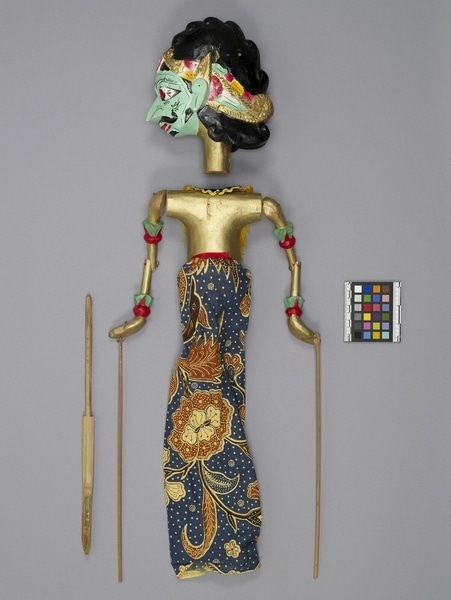Rod Puppet Item Number: Ib386 a-c from the MOA: University of British Columbia


Description
Three-dimensional male humanoid figure (part a) with large head (part b) and jointed arms attached to controlling rods. There is a single controlling rod that is tapered and pointed (part c). Light green face is positioned straight ahead and there are red lips and exposed teeth. Eyes, hair, moustache, and beard are in black. Straight pointed nose. Gold neck and torso. Headdress with red flower at forehead. Double sumping in gold and grey, red trim. Wide lungsen (and suri) in gold with green trim. Keling headdress with reverse hair curl with green at rear. Each arm has red and green ornaments at wrist and bicep; hands held flat and bent back at wrist. Black chest covering and apron with red waist band: decorated with wavy brown trim and green and red sequins. Yellow fringe at apron bottom. Lower torso covered by batik skirt (blue, dark brown on beige)
History Of Use
Javanese puppetry as an art form probably developed by the 11th century. Wayang golek puppets of western Java appeared during the 16th century. Originally the plays depicted Javanese mythology, but after the Indian conquest of Java the Hindu epics, Ramayana and Mahabharata, were incorporated into the cycles, which comprise about 200 plays. A dalang (puppet master) performs the plays to celebrate important occasions, usually in three acts, with vocal and instrumental accompaniment. Typically they serve a moral and religious purpose, and more recently, one of political commentary. Yudistira is the eldest and ruling member (prabu) of the Pandawa brothers, found in the Mahabharata cycle in conflict with their usurpers, the evil Kurawa brothers.
Cultural Context
Theatrical performance.
Iconographic Meaning
Each puppet is characterized by its wanda, a Javanese word which describes the specific mixture of elements of size, form, colour, ornamentation and carving. Colour and position of face, delicate features, and eyes indicate nobility, virtue, and youth. Headdress, position of hands and batik suggest rank and wealth. Overall configuration, particularly headdress identify character as Yudistira; identification as Semiaji either in error or puppet is an unusual variant.
Item History
- Made in Java, Indonesia
- Owned by Donald Bone before January 4, 1980
- Received from Donald Bone (Seller) and Museum of Anthropology Donations Fund (Funding source) on January 4, 1980
What
- Name
- Rod Puppet
- Identification Number
- Ib386 a-c
- Type of Item
- puppet
- Material
- fibre, paint, cotton fibre and wood
- Manufacturing Technique
- carved, tied, woven, sewn and painted
- Part A
- height 63.0 cm, width 16.5 cm, depth 9.5 cm
- Part B
- height 23.0 cm, width 10.0 cm, depth 18.0 cm
- Part C
- height 0.8 cm, width 36.5 cm, depth 1.5 cm
Who
- Culture
- Sundanese
- Previous Owner
- Donald Bone
- Received from
- Donald Bone (Seller) and Museum of Anthropology Donations Fund (Funding source)
Where
- Holding Institution
- MOA: University of British Columbia
- Made in
- Java, Indonesia
When
- Ownership Date
- before January 4, 1980
- Acquisition Date
- on January 4, 1980
Other
- Condition
- fair
- Accession Number
- 0586/0005 a-c